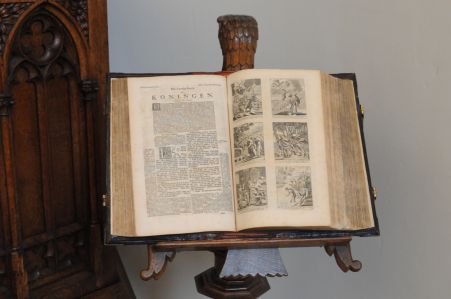Church | 1088 - 1987 | | Protestant Church



Map
Opening hours
't Keerske is open on Sundays for Protestant and Anglican worship.
For questions about a visit (individual or group), please contact the minister: j.a.deprenter@gmail.com.
Religious offices
Protestant worship service : Sunday 10 a.m.
Anglican worship service : Sunday 17.00 (winter) or 18.00 (summer)
Description
In 1127, blessed Charles the Good, count of Flanders, was murdered in the church of Saint Donatian; because of this the church was desecrated and one started looking for a different sanctuary to hold the memorial service; this became the Chapel of Saint Peter. In the beginning of the 14th century, the crossbowmen temparily made use of the chapel and pit, and by the end of the 16th century, came the guild of the chandlers.
In the 17th century, the chapel was renovated; one incorporated stained glass windows with coats of arms of benefactors, amongst which the family Van Gruuthuse. In the beginning of the 17th century, there was a renovation. The building also functioned during the ages as an inn, a disco, a boxing room, and as a storage facility.
Since 1960, it is classified as a monument, and since the 8th of December 1984, the chapel is being used for memorial services and churchly activities. It was restored in 1987.
Photos
Media
Remarkable elements
A protestant interior
The interior of 't Keerske consists of three central elements.
In the middle of the chapel, stands the Supper table, which is used to celebrate the Lord's Supper.
Next to the Supper table, stands the baptismal font. The baptism is given to children, with which one not only asks for God's blessing over the life of the child, but one also avows as parents of the child to commit as a family to the religious community. The Supper table was designed by a member of the community, and the baptismal font comes from the old English Church in the Ezel street (Reyandt hall). The layout of the church is very symbolic.
Next to the Supper table and the baptismal font, that refer to the two sacraments of the protestant church, stands the pulpit. This way, it is expressed that the Word and the sacraments mutually complement each other. Also the pulpit originally came from the old English church.
The stained glass window
The stained glass window in the upper hall depicts the Last Supper that Jesus celebrated with his disciples. It was created by a former member of the community, and was brought over from the previous church building in the Witte Leertouwer street. Every first Sunday of the month, the Holy Supper (also called the Lord's Supper) is celebrated. We know this to be an 'open table'. Everyone who has been baptised within the protestant or any other church, is welcome to take part.
The Huguenot cross
The Huguenots were French protestants who fought to freely celebrate their faith. They often wore the Huguenot cross which has a rich symbolism attached to it. The cross consists of four arrow shaped points with balls at the end points. These refer to the eight beatitudes of the Sermon on the Mount (Matt 5:3-10). Between the arms of the cross, one can see the leaves of a lily. Just like with most Huguenot crosses, they consist of three flower petals. In total, there would be twelve lily petals, a symbolic number that refers to the twelve apostles. Just underneath the cross, one can see a pigeon: a reference to the Holy Spirit.
The open Bible
On the wooden lectern with the eagle depicted on it, one can find an open States Bible which was printed in 1736. The Word is central to the protestant worship. The Bible is to the protestants the source and the norm for their faith and life. It is typical for a protestant to read the Bible for themselves, free from churchly doctrine. Also the wooden lectern comes form the old English church. The eagle is a biblical symbol and refers to God's loyalty. (cf. Deut 32:11-12).
Wooden panels
On the walls in the stairwell, one can see exceptional wood carvings. On the wooden panels, the most important theologians for the protestant tradition are depicted. Amongst them, also the reformers Martin Luther, John Calvin, and Ulrich Zwingli.
Crypt
't Keerkse previously was made up of an upper- and a lower church, whereby the upper church was dedicated to Saint Peter, and the under chapel of the crypt was dedicated to Saint Catherine. That's why she was also named 'Saint Catherine in the Pit".
Nearby
Circuit
Religious heritage in Bruges: walk with the precursors of the faith!

Together with the deanery of Bruges, Open Churches released a brochure describing a walk through Bruges, guiding you along the 11 principal churches in the town centre. The 9 km route invites you to walk in the footsteps of the pastors of our faith. You can explore the splendour and grandeur of our religious heritage and discover the legends and tales which surround the life of our saints and patron saints.


























